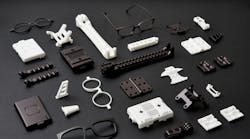At A Glance:
- A study finds 88% of users agree software adoption would accelerate use of additive manufacturing.
- Real-time tracking of materials and processes and industry-specific information are among the most-desired software tools.
- As more companies adopt additive manufacturing for production processes, the cycles of innovation and improvement will continue.
Software certainly is no stranger to traditional manufacturers. For decades, it has played an increasingly undeniable role in streamlining operations while empowering manufacturers of all sizes to meet high-volume production demands with maximum quality and efficiency, from uploading part or product designs to providing full production planning and manufacturing straight on to product delivery. Simply put, software must be tailored to support the unique and different process flows that dictate how products are designed, made and delivered using additive manufacturing.
While these vital software applications are the lifeblood of traditional manufacturing organizations, they haven’t been designed to support the speed and agility associated with end-to-end additive manufacturing processes. As a result, proponents of additive manufacturing, commonly called 3D printing, have been forced to cobble together disparate solutions to handle discrete processes and workflows. According to the “State of 3D Printing” survey commissioned by Shapeways in July of 2021, 72% of those polled use six or more tools or applications to manage the processes needed to make a typical product using 3D printing.
The three tools used most frequently are shared data repositories such as SharePoint or Google Docs, Excel or standalone documents and machine scheduling tools. Only 29% of the respondents reported the use of applications with integrated and cohesive workflow management, while 88% agree better software would accelerate their adoption of 3D printing.
Lack of Software Has Slowed 3D Printing’s Trajectory
So, why has software been slow to support additive manufacturing? After all, 3D printing technology has been around for more than 30 years, and it continues to make major inroads proving its worth in high-mix/low-volume manufacturing applications. Additive manufacturing is ideally suited for producing parts or products with complex geometries while dramatically reducing the number of separate components needed to produce a highly complicated part or product.
The spotlight on additive manufacturing intensified during the pandemic when 3D printing technologies were used to produce record numbers of life-saving personal protective equipment (PPE) in fighting the spread of COVID-19. In most cases, traditional manufacturing was outmatched by the speed and agility of 3D printing to address evolving requirements and rigorous timelines. There simply wasn’t sufficient time to take the traditional manufacturing route to market, which also helped dispel long-held misconceptions about additive manufacturing.
Manufacturers previously had relegated 3D printing to a handful of roles, such as handling rapid product design iterations and producing functional prototypes or one-off product orders. A variety of reasons are credited for the holdup in overall acceptance, including unfamiliarity with new processes, misconceptions about quality and volume issues, and trepidation about transitioning traditional manufacturing routines to new ways. Regardless, one thing is for sure: Software is poised to remove the barriers while easing widespread transition of additive manufacturing.
Supporting End-to-End Digital Processes
To fulfill the potential of additive manufacturing, a new class of software must be capable of managing end-to-end digital processes and workflow—from uploading part or product designs to providing full production planning and manufacturing straight on to product delivery. This software must be tailored to support the unique and different process flows that dictate how products are designed, made and delivered using additive manufacturing.
Survey respondents identified the top five software features that would most benefit additive manufacturing adoption:
- Real-time tracking and traceability
- One interface to manage internal workflows and external supply chain
- The ability to attain data needed for industry-specific certifications
- Vendor-agnostic hardware or materials
- A single view into the end-to-end manufacturing process
Where additive manufacturing software promises to be most transformative is when embraced by small CNC shops or design firms and mid-sized manufacturers. Embracing additive manufacturing empowers these organizations to not only design products with complex geometries, but manufacture them as well. That would be highly challenging or outright impossible utilizing traditional manufacturing methodologies. These organizations typically don’t have massive incumbent infrastructure, the luxury of giant capex budgets or far-reaching expertise—they might not even have MES software to drive portions of their operation.
By embracing a digitized manufacturing process, items can be produced closer to end-customers, therefore reducing potential logistics bottlenecks and shipping delays. This reality alone should be enough to get even the most diehard skeptics to consider additive manufacturing.
For them, software lowers entry barriers and then levels the playing field, giving them immediate design-to-deliver capabilities needed to compete with larger and more entrenched organizations. Software democratizes additive manufacturing by giving more organizations much-needed access to the tools and processes needed to succeed.
Digital manufacturing software also can reduce CAPEX and OPEX concerns by enabling shared and distributed access to world-class manufacturing machines and services. In particular, small to mid-sized manufacturers quickly can reap the benefits of this new business model, which could be categorized as print-as-a-service. The result lets a solo designer of individualized jewelry share the same footing with a manufacturer that produces millions of parts, pieces or products. Instead of having to find a partner—or not playing in the game at all—software can create unprecedented opportunities to engage and participate in a fast-growing market segment.
Cue the Network Effect
As more manufacturers embrace additive manufacturing software, the democratizing process gets stronger and better. It becomes a constant, continuous cycle of improvement and innovation. As the number of makers, sellers and buyers in the network increases, the so-called “network effect” amplifies value for all its members. This rings true especially in ensuring supply chain readiness, as members across the network can tap into each other’s areas of expertise as well as ubiquitous access to vendor-agnostic technologies, along with world-class materials and finishes.
Software designed for additive manufacturing also can reduce obstacles for achieving desired part tolerances and consistency, which typically have been the biggest concerns facing newcomers to this arena. File analysis and optimization with instant auto-correction functionality, as well as complete traceability with pre- and post-production capabilities, ensure delivery of top-quality, finished products anywhere in the world.
Exceptional Customer Experience
Ultimately, delivering a consistent and exceptional customer experience is the holy grail for every manufacturer. The fulfillment aspect is a big part of that customer experience. These days the impact and importance of the supply chain is on everyone’s mind, and additive manufacturing software can prove its worth here. By embracing a digitized manufacturing process, items can be produced closer to end-customers, therefore reducing potential logistics bottlenecks and shipping delays. This reality alone should be enough to get even the most diehard skeptics to consider additive manufacturing.
The journey to additive manufacturing starts like any other—with taking that first step. Embracing the latest additive manufacturing software jumpstarts those initial forays while providing a path forward as the pace of adoption accelerates. The bottom line is while every manufacturer wants to stand out, they also want to take advantage of every capability their peers have, and these days that includes additive manufacturing.
Yan Liang is senior vice president of products for Shapeways. Her responsibilities include driving product management and strategy for the company, a leader in digital manufacturing. A graduate of the University of Michigan, she came to Shapeways after serving in product engineering at SAP and Symantec.


